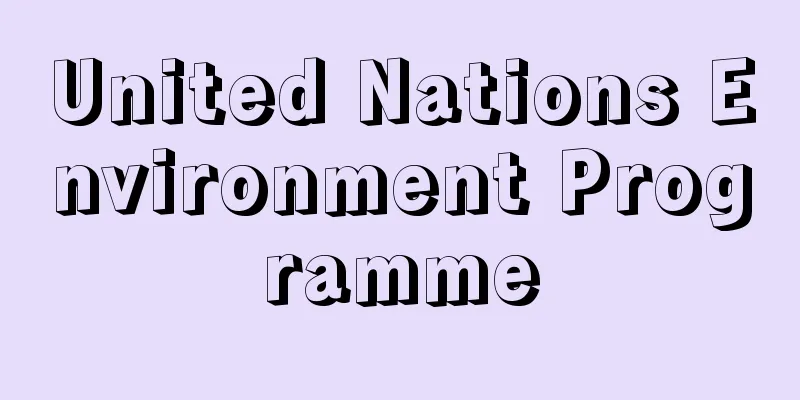United Nations Environment Programme

|
It is a subordinate body of the United Nations General Assembly established in 1972 based on the 27th UN General Assembly Resolution 2997 for the purpose of protecting and improving the environment. Its abbreviation is UNEP. Its secretariat headquarters is in Nairobi, Kenya, and it has six regional offices around the world. Initially, the Governing Council was composed of 58 countries. However, at the United Nations Conference on Sustainable Development (Rio+20) held in 2012, it was decided to reorganize the Governing Council into the United Nations Environment Assembly (UNEA), which all UN member states can participate in, as a measure to strengthen UNEP. Its objectives are to coordinate all environmental activities and to promote international cooperation on new problems, based on the "Declaration on the Human Environment" and "International Programme of Action for the Environment" adopted at the United Nations Conference on the Human Environment (Stockholm Conference) in June 1972. The areas it covers include global warming, the ozone layer, the marine environment, biodiversity, water resources, soil, hazardous waste, chemicals, and heavy metals. In this regard, the development of environmental legal systems is also important, and efforts have been made to research and raise awareness of environmental issues, promote the creation and ratification of environmental treaties, and develop corresponding domestic laws and ensure their enforcement. With regard to environmental treaties, the Agency also serves as the secretariat for the Washington Convention, the Vienna Convention for the Protection of the Ozone Layer, the Basel Convention, and the Convention on Biological Diversity. On the other hand, with regard to the development and enforcement of domestic laws, the Agency has been providing developing countries with capacity building and technical assistance in compliance with laws and regulations, and for this purpose adopted the Bali Strategic Plan at the 23rd Management Council meeting (2005). In addition, the United Nations Environment Programme International Environmental Technology Centre was established in Osaka. [Hiroshi Isozaki September 17, 2021] United Nations Environment Programme International Environmental Technology CentreThe UNEP-IETC (UNEP International Environmental Technology Centre) aims to strengthen the role of the UNEP in sustainable urban and freshwater lake basin management. It was established in Japan in October 1992 based on UNEP Governing Council Resolution 16-34 of May 1991, and offices were opened in Osaka City and Kusatsu City, Shiga Prefecture in April 1994. The Osaka office focused on integrated environmental management of large cities (waste management program), while the Shiga office focused on integrated environmental management of freshwater lake basins (water and sanitation program). The background of the waste management program is the rapid increase in waste electrical and electronic equipment (WEEE), agricultural biomass waste, plastic waste, etc. in developing countries. Most of these wastes can be recycled using environmentally sound technologies (EST). Therefore, the waste management program is based on the 3Rs (Reduce, Reuse, Recycle) and aims to ensure proper management and recycling with the participation of all stakeholders, and includes demonstration and pilot projects, technical assistance, and capacity development. The Water and Sanitation Program also provided much needed support to disseminate Environmentally Sound Technologies (ESTs) for water supply and wastewater management in order to achieve the goal of "halving the proportion of people without access to safe drinking water and sanitation" set out in the World Summit on Sustainable Development (WSSD, 2002) and the Millennium Development Goals (MDGs). In 2011, the Shiga office was closed and merged with the Osaka office. Since then, IETC has continued to focus on environmentally sound regulatory management of waste and chemicals and has played a role as a global hub for this purpose. In addition, since 2020, IETC has been implementing the "UNEP Action for Sustainability," building a cross-sectional network to promote collaboration and cooperation between the United Nations, governments, companies, citizens, and other organizations, and supporting activities aimed at resource circulation and a sustainable society. [Hiroshi Isozaki September 17, 2021] [Reference items] | | | | | | |Source: Shogakukan Encyclopedia Nipponica About Encyclopedia Nipponica Information | Legend |
|
1972年の第27回国連総会決議2997に基づいて、環境の保護と改善を目的に設立された国連総会の下部機関。略称はUNEP。事務局本部はケニアのナイロビに置かれており、世界に六つの地域事務所がある。当初、管理理事会は58か国で構成されていた。しかし、2012年に開かれた国連持続可能な開発会議(リオ+20)において、UNEPの強化策として、管理理事会をすべての国連加盟国が参加できるUNEA(国連環境総会)に改組することが決められた。 1972年6月の国連人間環境会議(ストックホルム会議)で採択された「人間環境宣言」および「環境国際行動計画」に基づいて、環境にかかわる諸活動の全般的な調整を行い、新たな問題に関する国際協力を行うことを目的としている。対象とされる分野は、温暖化、オゾン層、海洋環境、生物多様性、水資源、土壌、有害廃棄物、化学物質、重金属など、さまざまな分野にわたる。 その関連で、環境法制度の整備も重視されており、環境問題の調査研究と注意喚起、環境条約の作成と批准の促進、対応する国内法の整備と執行確保などが行われてきている。環境条約については、ワシントン条約、オゾン層保護のためのウィーン条約、バーゼル条約、生物多様性条約などの事務局機能も担っている。他方、国内法の整備と執行確保については、開発途上国に対して、法令遵守に関する能力構築および技術支援を行ってきており、そのための「バリ戦略計画」を第23回管理理事会(2005)において採択した。 なお、大阪に、国連環境計画国際環境技術センターが設置された。 [磯崎博司 2021年9月17日] 国連環境計画国際環境技術センター国連環境計画国際環境技術センター(UNEP-IETC:UNEP-International Environmental Technology Centre)は、持続可能な都市および淡水湖沼流域の管理について国連環境計画の役割を強化することを目的としている。1991年5月の国連環境計画管理理事会決議16の34に基づいて1992年(平成4)10月に日本に設置され、1994年4月には大阪市と滋賀県草津市に事務所が開設された。大阪事務所は大都市の統合的環境管理(廃棄物管理プログラム)を、滋賀事務所は淡水湖沼集水域の統合的環境管理(水・衛生プログラム)を中心に活動した。 そのうち、廃棄物管理プログラムの背景には、開発途上国では、電気電子機器廃棄物(WEEE)、農業バイオマス廃棄物、プラスチック廃棄物などが急増していることがある。それらの廃棄物の大半は環境上健全な技術(EST:Environmental Sound Technology)により再生利用が可能である。そのため、廃棄物管理プログラムは、3R(Reduce、Reuse、Recycle)を基礎として、すべての利害当事者が参加したうえで適切な管理と再生処理を行うことを目的としており、実証・パイロット(試験的)プロジェクト、技術支援、能力開発などが行われている。 また、水・衛生プログラムは、「持続可能な開発に関する世界首脳会議」(WSSD:World Summit on Sustainable Development、2002年)および「ミレニアム開発目標」(MDGs:Millennium Development Goals)に定められている「安全な飲料水と衛生設備が確保できない人々の割合を半分にする」という目標の達成に向けて、上水供給および排水管理に必要とされる環境上健全な技術(EST)の普及を目的として、必要とされる支援を提供した。 2011年(平成23)に、滋賀事務所は閉鎖されて大阪事務所に統合された。それ以降、IETCは、引き続き環境上適正な廃棄物および化学物質の規制管理に重点を置き、そのための世界的な拠点としての役割を果たしてきている。また、2020年(令和2)からは、「UNEP持続可能性行動」を展開しており、横断的なネットワークを構築して、国連・政府・企業・市民・その他団体の連携・協働を促進し、資源循環や持続可能な社会を目ざす活動を支援している。 [磯崎博司 2021年9月17日] [参照項目] | | | | | | |出典 小学館 日本大百科全書(ニッポニカ)日本大百科全書(ニッポニカ)について 情報 | 凡例 |
>>: United Nations Conference on Environment and Development
Recommend
Organizer - Ogainaza
A PIM developed by Lotus. It can manage schedules,...
Maesawa [town] - Maesawa
An old town in Isawa County in southern Iwate Pref...
Otto, K. - Oops
...His popular works, intended as entertainment, ...
Liu Biao (English spelling)
? ‐208 One of the heroes of the late Eastern Han D...
Ozaki Memorial Museum
…After the war, he was a senior member of the Die...
Notice disposition - Tsuukokushobun
When tax authorities are convinced of a violation ...
Gomberg, M.
…In the Wittig reaction, the intermediate ylide p...
La Caricature (English)
…It ran from 1832 to 1893. It was published by th...
Ashijiro's Sword - Ashijiro's Sword
A sword with silver leg hardware. ※ Heike (early 1...
Persimmon stalk moth - Kakivoria flavofasciata
It belongs to the order Lepidoptera, family Mammal...
Delorme (English spelling) Philibert Delorme (de l'Orme)
French Renaissance architect. Born into a family ...
Jebb, Sir Richard Claverhouse
Born: August 27, 1841, Dundee [Died] December 9, 1...
Ionophore antibiotics
…Novobiocin acts on bacterial DNA gyrase (an enzy...
clasp knife phenomenon
...In other words, the stretch reflex is in an en...
Carolus-Duran, EA - Carolus-Duran
…In the early Hakuba-kai exhibitions, he exhibite...





![Kudamatsu [city] - Kudamatsu](/upload/images/67cb6947da5ba.webp)



